Indian’s a name that needs no introduction to the heavyweight cruiser scene, but its new fleet of Chieftain baggers is certainly worthy of some noise. Dave Manning tells us what we need to know…
While circuit racing has been very distant from the world of laid-back, American-style cruiser motorcycles, there has been something of a tidal change of late, thanks to the King Of The Baggers race series in the US. The fully dressed, big inch vee twins from Harley and Indian battle it out in an exciting fashion on the racetracks of North America.
Given the expanding popularity of the King Of The Baggers race series, the success of the Indian ‘wrecking crew’, which for 2025 is now a three-rider team, including ex-MotoGP and WSB racer Loris Baz, has undoubtedly shed more light on their range of cruisers, specifically those with hard luggage that reflect the baggers on the race track.
Enjoy everything More Bikes by reading the MoreBikes monthly newspaper. Click here to subscribe, or Read FREE Online.
The ‘wrecking crew’ team name comes from the world of flat track in which the hugely successful Indian FTR750 race bike no longer competes (after the introduction of rule changes that were presumably aimed at expanding the field), but it could be argued the King Of The Baggers series has more in common with the sort of folk who spend their hard-earned on the product that is available at your local motorcycle dealer.
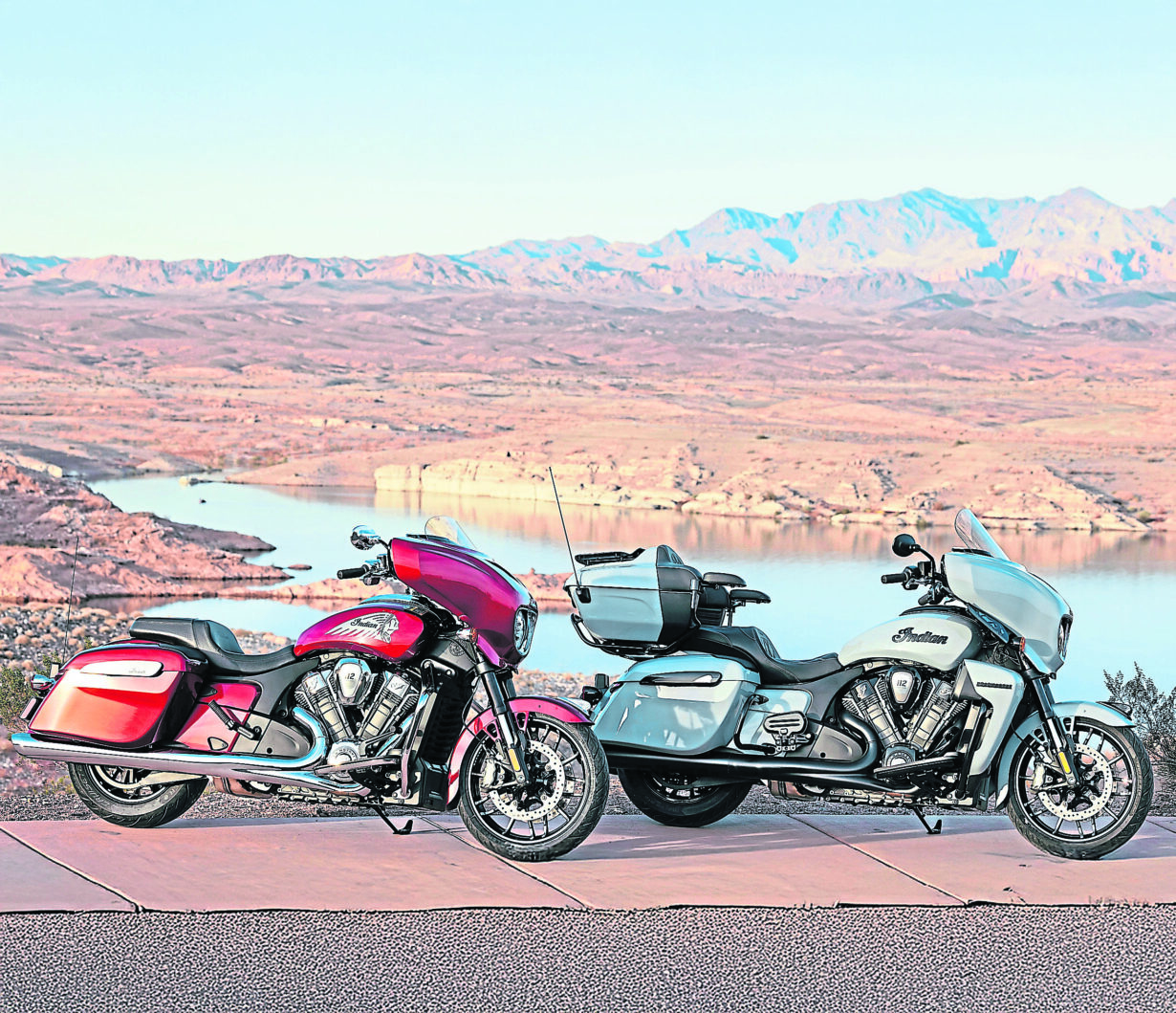
The FTR750 was never a road bike, nor could it be bought at your nearest bike shop, whereas bikes such as the Indian Chieftain and Challenger are available for you to buy and ride away tomorrow. And besides, the phrase ‘Win on Sunday, sell on Monday’ was coined at a time when race machinery was very different to that which rolled off the production line, and was more of a referral to the badge that appeared on the tank (or bonnet) rather than the precise bike (or car) used in competition.
But I digress. What we’re looking at here are new machines from Indian, at a time when the racetrack results are giving the manufacturer some important publicity. For 2025, the Springfield factory has enhanced their water-cooled Powerplus engine (that was initially brought into the product line in 2019), with a four cubic inch larger capacity attained by a bigger bore, with the engine’s stroke remaining as per the 108 model, although changes aren’t just limited to engine internals.
The head honcho behind Indian’s design team, Ola Stenagard, gave us some insight to the design and production process for the models that use the new Powerplus engine, and he reiterated the phrase he used with last year’s launch of the new Scout models. That of ‘three reads’ – the way we observe a bike in three ways. Firstly, at a distance and appreciating the overall form and proportions, then closer with observation of surfaces and textures, and finally at the details and build quality.
While the company’s Chieftain with its fork-mounted fairing has proved to be a great seller, the air-cooled engine is no longer viable for sale in Europe, so a version of the Chieftain using the water-cooled Powerplus engine (as seen with the Challenger and Pursuit launched two years ago in Chamonix, equipped with frame-mounted fairings) was deemed necessary. Indian still use clay-modelling (alongside sketches and CAD) to finalise the designs, with the convenient side effect that a clay model can be used for wind tunnel testing and be easily tweaked and changed to suit or improve.
Aside from creating those vital surfaces for the ‘second read’, you may see some muscle car influences that directed the design team in the form of the fairing and headlight surround, all of which points to the fact this wasn’t just a case of whipping the fork-mounted fairing off the old air-cooled Chief platform and bolting it on to a Challenger/Pursuit – it’s a far more involved development that has approached the process in the same way as building an entirely new model, yet retaining the style and designs for which Indian have become known.
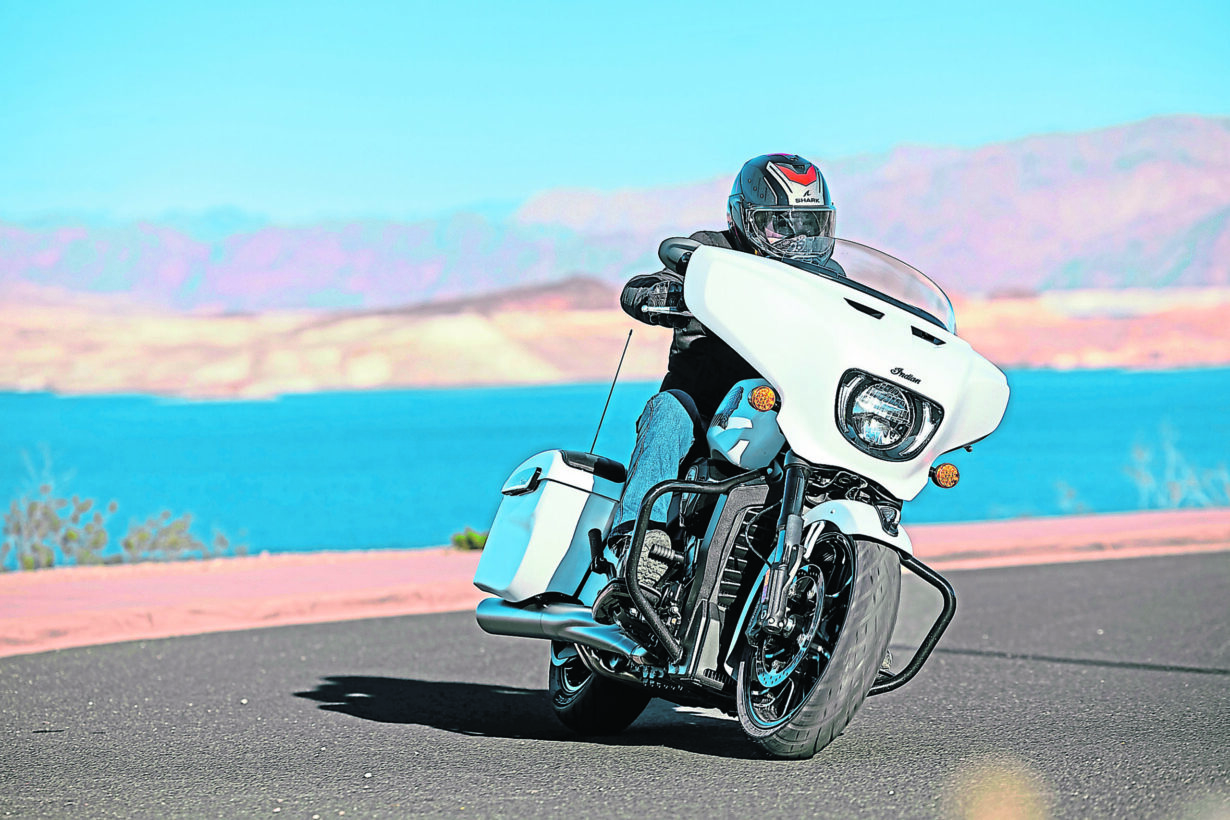
The priorities that were decided upon, bearing in mind it’s a heavyweight cruiser, were style, performance and technology. The first is obvious, the second less so, but a direct influence coming from the racing successes, while the final is due to something of a shift in customer demand.
A decade ago, cruiser owners had no interest in having new technologies added to their bikes, but that’s different now, they actually want it, and in all the different ways that it can be delivered – not just in safety and control, but in entertainment and efficiency, too.
The style and functionality of the cruiser market is routed in heritage. But it’s now evolving forwards. The prime example is the rider assist options that have been added in order to aid the rider in terms of safety, yet not be distracting. The radar-operated rear and side proximity warnings, that show on the dash and in the mirrors respectively, can be switched off and, thanks to the widget on the touchscreen dash, this is an astoundingly easy one-touch process. Even a technophobe such as myself can suss it in seconds.
What is an important safety function on busy motorways could quite easily become exceedingly irritating and distracting in heavy town traffic (especially so at night and in the rain, flashing lights galore!), and the ease at which it can be turned off is a masterpiece! And there’s rear cylinder deactivation when at a standstill, too, which you can aurally notice, aiding fuel consumption and reducing heat soak from the rear pot.
‘Rider modes’ is a phrase that, until very recently, wouldn’t have been in a cruiser owner’s lexicon, yet here we are on a 2025 cruiser that has three rider modes (Rain, Standard and Sport), and the ride-by-wire throttle control that enables this also allows for supremely efficient cruise control.
Not so very long ago, a mile-munching cruiser such as this would have cruise control (invariably mechanically operated, that would speed up on downhills, and go slower on climbs), and an entertainment system that had a radio, and maybe a tape player. The entertainment suite on the Indian is flexible – an easy-to-access radio supplemented by Apple CarPlay with automatic overrides for phone calls and satnav operation, while the speaker set up, while already impressive, has a factory upgrade for those who wish to entertain the entire state with their personal choice of music (or podcast, for that matter).
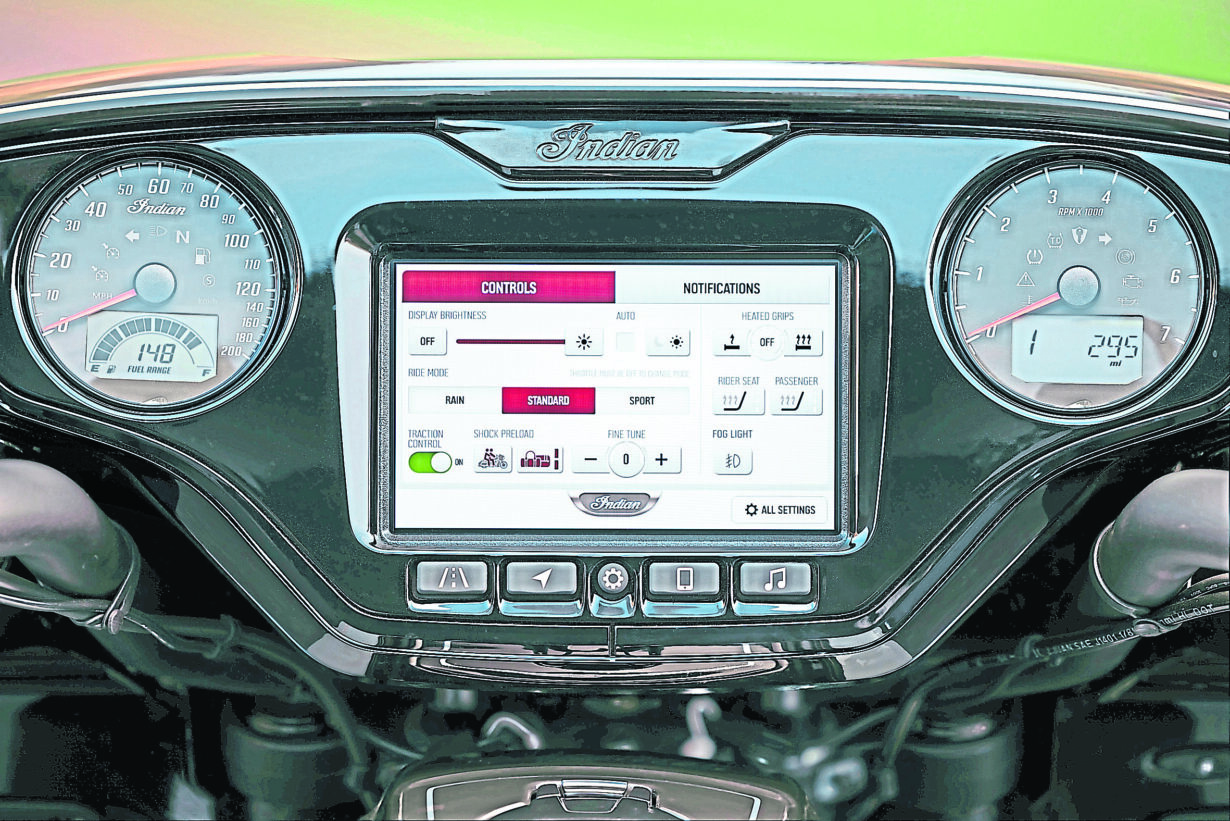
There’s more, too, with a hill-hold function, and electronically linked brakes (that applies the rear when using just the front, and vice versa) with lean-sensitive ABS thanks to the new 6-axis Bosch IMU. Given that overall mass, the Brembo radial calipers do a decent enough job of hauling the plot to a stop, and there’s some good feedback from the lever, too, which isn’t something that can always be said about cruisers.
The spec sheet lists the seat height at a mere 672mm, although that figure is somewhat deceptive as the riding position and the width of the seat itself means that you’ll not have the feeling of being quite that low to the ground. That said, having your feet flat on the floor, with knees bent, does go some way to contradicting both the 366kg mass, and the physical dimensions of both the Chieftain and Roadmaster models.
We rode the new Chieftain (and Roadmaster) on the desert roads east of Las Vegas, with the fast and swooping highway running alongside Lake Mead (the large body of water created by the construction of the Hoover Dam) proving just how well the bike handles at speed, and while there were some strong winds present, the ‘batwing’ fairing didn’t affect the handling in the same way that I’ve noticed on other similarly-styled bikes – only the vaguest of weaves when leant over on undulating corners when really pressing on.
And that Powerplus motor really can press on! 126 horsepower may not sound much in these days of 200bhp litre bikes, but that stump-pulling 133.8lb-ft of torque really fires the bike out of corners. Yet the power delivery was flexible, and accessible, and the tight and twisty corners through the Valley of Fire State Park were a true pleasure, with the neutral handling excelling at showing how well over 400kg of mass (with me aboard) can be piloted with ease and precision. That might sound a little too gushing, but I was impressed!
We spent a good half-hour on some fast freeway, too, giving us the chance to sample the easy-to-use cruise control, and to fiddle with the electrically-adjustable screen that offers 100mm of adjustment – the lowest looks the best, the highest is the quietest.
While the Chieftain I rode was in an understated satin white colour scheme, models available in the UK will be of the Metallic Black or Sunset Red metallic schemes, while the Dark Horse versions (with no chrome) come in the satin finish Black Smoke (as seen in the annotations picture) and Sunset Red Smoke liveries. And the finish is deep, lustrous and, given that’s there’s a five-year warranty, probably rather hard-wearing, too.
Challenger and Pursuit 112
The factory’s two models that have the fairing fixed to the frame – rather than to the fork – are the Pursuit and the Challenger (shown here). Both are now fitted with the larger Powerplus engine, plus the improved electronics and sound systems like the Chieftain and Roadmaster.
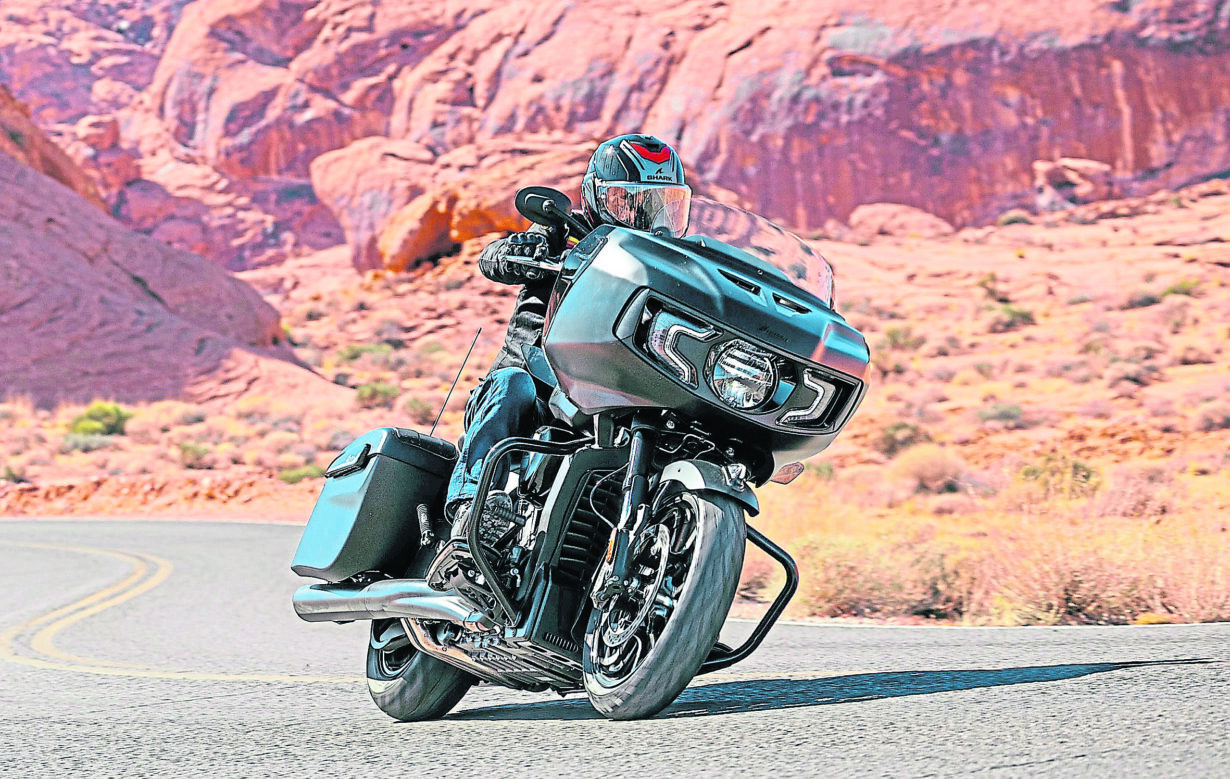
Roadmaster 112
While it retains the same fork-mounted fairing as the Chieftain, the Roadmaster has additional leg shrouds (with extra speakers), plus a capacious 140 litres of luggage capacity with the top box, thus moving away from the popular ‘bagger’ style and closer to a more traditional ‘full dresser’ touring machine.
Other things to know…
Engine: Development of the water-cooled 60° vee twin has resulted in a capacity of 112 cubic inches (or 1834cc in real money) and an impressive torque output of just shy of 134ft-lb.
Frame: Cast alloy as per the Pursuit and Challenger, rather than the steel frame used for the air-cooled Chieftain and smaller Scout, more likely chosen for the ease of manufacture of the specific shape required rather than for any performance benefits.
Brakes: With the overall mass, there’s a lot for the brakes to deal with, but the Brembo four pots and 320mm discs cope admirably, with a good level of feel and feedback, while the hill-hold facility (somewhat vital on such a big bike) is switchable, and can hold for as long as three minutes!
Rider modes: Unlike some machines, there’s no confusion here with a vast array of options, just three modes with obvious suitability – Rain, Standard and Sport – with Rain cutting the power output, and throttle sensitivity being changed in the other two.
Switchable safety: We’re used to things like traction control being switchable, but the Indian expands that to safety devices that may, at times, actually be distracting to the ride. The rear radar that detects approaching vehicles, etc., and gives a visual warning on the dash and/or in the rear-view mirror can be switched off.
Aftermarket goodies: Indian’s options aren’t just aimed at owners having some individuality, but also at improving rider fit and comfort, A production bike is going to be a compromise in terms of ergonomics, and the range of aftermarket parts negates that issue. There are over 90 factory accessories.
Suspension: Despite having little in the way of adjustability – with just an electrical preload on the rear shock operated through the touchscreen dash – the suspension deals with the significant mass in an impressive fashion.
Specs: Specification
Make and Model: Indian Chieftain 112
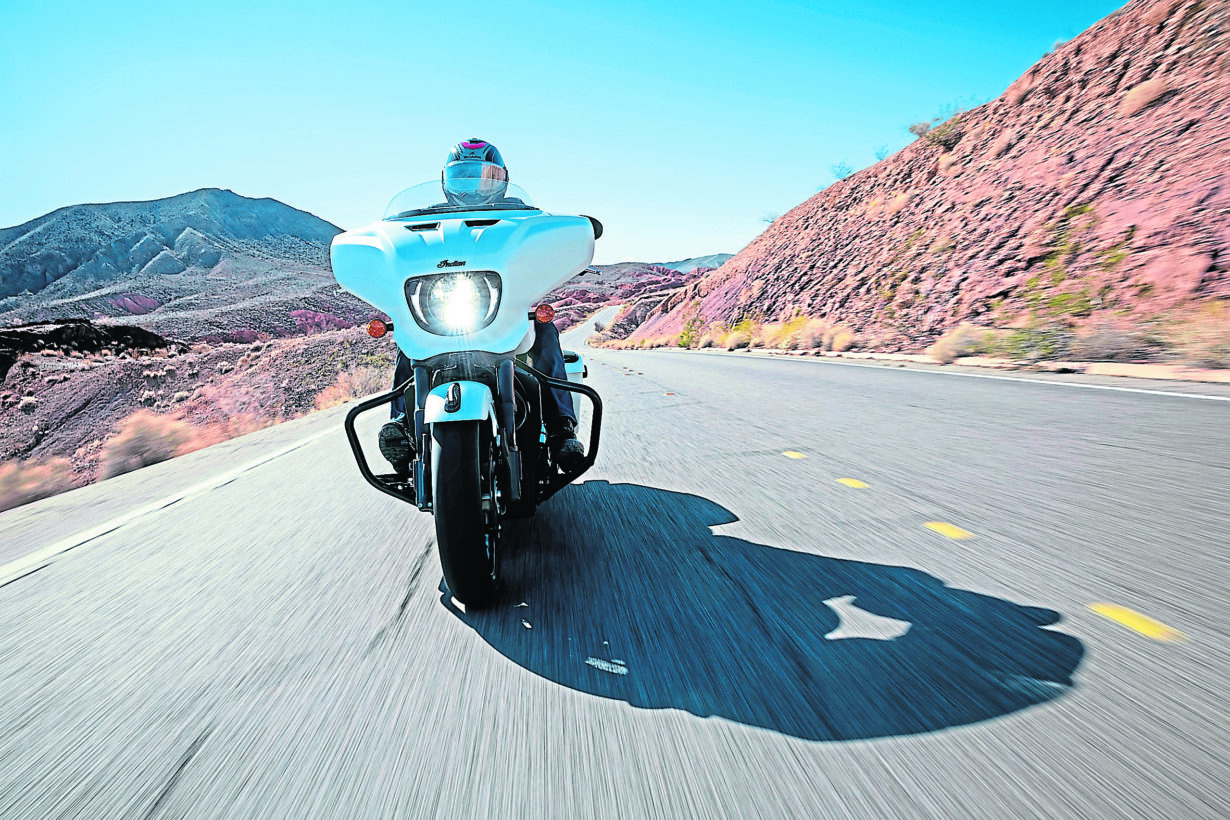
Price: £26,895
Engine: 112” (1834cc), 60° vee twin, water-cooling, SOHC, 4 valves per cylinder, dual throttle bodies, 110mm x 96.5mm bore/stroke
Power: 126bhp (94kW)
Torque: 133.8 lb-ft (181.4Nm) @ 3800rpm
Frame: Cast aluminium
Wheelbase: 1668mm
Rider aids: 3 ride modes (Rain, Standard, Sport), cruise control, lean-sensitive ABS and traction control, blind spot warning, rear collision warning lights, tailgate warning, bike hold control
Brakes: Electronically linked (F) Radial 4 piston Brembo calipers, semi-floating 320mm discs, (R) 298mm disc, 2 piston caliper
Transmission: 6 gears, belt final drive
Suspension: (F) 43mm inverted forks, 130mm travel, (R) single shock, hydraulic preload adjustment, 114mm travel
Wheels/Tyres: 10-spoke machined cast aluminium wheels (F) 130/60×19” Metzeler Cruisetec tyre, (R) 180/60×16” Metzeler Cruisetec tyre
Seat height: 672mm
Fuel capacity: 22.7 litres
MPG: n/a
Weight: 366kg (382kg with fuel)
Warranty: 5 years
Contact: www.indianmotorcycle.co.uk


